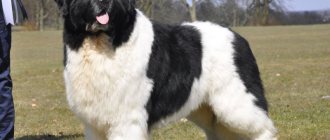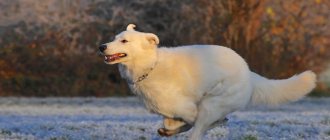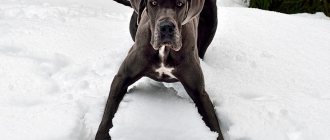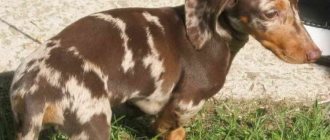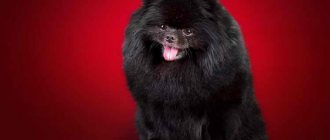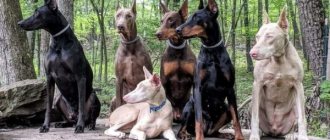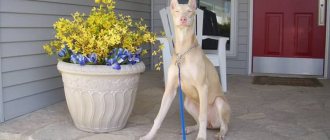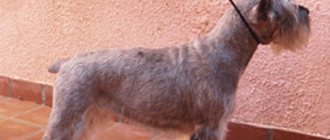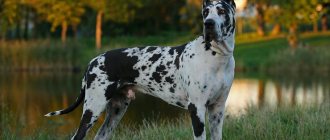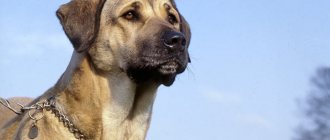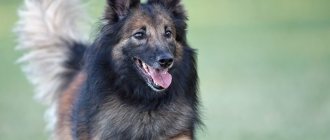| Origin: | Belgium |
| Usage: | in pastures, in protection |
| Color: | shades of red-red with black splashes, areas of white |
| Dimensions: | male height 62-66 cm, weight 26-31 kg; female height 58-60 cm, weight 20-26 kg |
| Lifespan: | 12-15 years |
Belgian Shepherds are known throughout the world as excellent guards and shepherds. Among them, the Laekenois subspecies stands out; they are also mistakenly called Lekenua or Lanois. Its representatives captivate with their powerful physique, stateliness and unusual tousled coat. However, in addition to external features, the breed has many specific traits in character and behavior.
Dossier
Height of an adult dog: 56-66 cm. Weight: from 25 to 35 kg. Characteristic color: various shades of red, fawn with blackening on the muzzle, tail, white spots on the chest and fingers are allowed. Coat length: up to 6 cm, hard, curly. Life expectancy: from 12 to 15 years. Advantages of the breed: smart, has a good memory, obedient. Difficulties of the breed: freedom-loving, prefers to live in a pack. Average price: from 360 to 800 dollars. Classification: shepherd, guard, guide for the disabled.
Appearance
In the photo, Laekenois stands out sharply among its Belgian counterparts. Coarse fur appears ruffled, causing the dog's body and face to appear different. In fact, all four lines of “Belgians” have a similar body structure. Inexperienced dog lovers may even confuse them with German Shepherds. The Laekenois' appearance, look and behavior demonstrate confidence, courage and alertness. Usually bitches are more flexible than dogs. The standard provides the following indicators of weight and height, depending on gender:
- Male: 62 cm; 26–30 kg.
- Female: 58 cm; 20–26 kg.
Origin story
The ancestors of Belgian Shepherds were European dogs that lived in the Middle Ages. Dogs similar to Lecanois were first mentioned in 1650. They were united only by their special ability to gather sheep, protect them in danger, and protect them at night. Until 1891, dogs were of different types. Dog breeders began to carry out breeding work. The breed standard was adopted in 1901 and their type was established by 1910.
By color they were supposed to be black with long hair, red-brown short-haired, gray wire-haired. Having received such an individual, it was named Laekenois. This is the name of the royal castle. This species is not particularly attractive, and its working qualities are also lower than those of the others. The breed is not yet recognized by world organizations; it is very rare.
Did you know? During the First World War, Belgian Shepherds helped remove the wounded and delivered ammunition to the front line.
We will give a description of the dog’s appearance according to standard characteristics
The head has a regular elongated shape. The Laekenois's muzzle resembles a rectangle, the bridge of the nose is straight, the lips are thinly compressed. The dog's jaws are easy to open, and the mouth is equipped with strong teeth. There is a pincer bite.
The dog's nose is black and has an excellent sense of smell. The eyes are slanted and have an elongated appearance. The eyelids are dark in color and have a brown or black iris around them.
The ears are located on top of the head and have a small triangle shape. The neck is long and has a high waist. The withers are practically invisible, there is no dewlap.
The body is strong with a large chest and rib system. The back is flat, short, flowing into a strong lumbar region and a slightly sloping croup.
The tail has an average length. When at rest it is located at the bottom, the tip has a slightly curved appearance. The dog's limbs are strong, elongated, the bones are strong, the paws are round.
Purpose
Laekenois was bred for guard duty. When Queen Maria Henrietta ruled the country, the breed was used as shepherds, guards of sheep, cows, and bulls. Dogs also guarded places where people bleached flax. The breed is now very small in number and ranks last among Belgian Shepherds in terms of numbers. Laekenois has a strong character and is very angry, which is why it is widely used in guard and security services.
Upbringing
Considering the size, weight and difficult nature of the Belgian Shepherd, it is necessary to start training the sooner, the better. Laekenois puppies need to be “out into the world” more often, into human society. Otherwise, the dog will be aggressive towards all strangers. It is also worth making acquaintances with other dog owners so that the Laekenois grows up socialized.
Like all shepherds, representatives of this breed are very smart and easy to train. But they are also capricious. It is important for the owner to establish contact between himself and the dog and give it the necessary motivation. You can't hit a puppy. He will either grow up intimidated, or later he will take revenge on you a hundredfold for all his childhood insults. Praise your pet often. Herding dogs, due to their working qualities, sometimes need to make independent decisions. You must gently show that everything in the house depends on you.
Character
- This breed of dog is very active, intelligent, and an excellent watchdog. On pastures he can freely drive cattle on his own, direct them in the right direction, and drive away thieves, animals, and vultures.
- Easily remembers commands and carries them out clearly.
- He reacts very sensitively to any dissatisfaction of the owner . If a dog is not trained to socialize, it can grow up to be aggressive or, conversely, timid.
- Proper training will ensure that you have a balanced, wonderful friend, companion, and guard.
- Families with children can safely get a Laekenois dog. Although they are not playful, they can completely obey the child. They become more attached to one person, but often require attention from other family members.
- Breeders of Laekenois shepherd dogs warn that you should not look into her eyes intently and continuously, this will cause aggression in the dog.
- They are very efficient , and if you surround the animal with care and warmth, they are able to move mountains for their owner.
- They feel comfortable when they live in a pack; there will always be a leader among them. This is the smartest, brightest representative of the Belgian Shepherd breed.
Breed traits
Breed traits (on a 5-point scale)
| Belgian Shepherd Laekenois | |||
| Activity | in the house | 3.2 | |
| on the street | 4.8 | ||
| Obedience | training | 4.8 | |
| strangers | 3.8 | ||
| Domination | in family | 2.2 | |
| over dogs | 3 | ||
| Defending your territory | from people | 3.6 | |
| from dogs | 4.2 | ||
| Sociability | in family | 5 | |
| with strangers | 2.6 | ||
| with dogs | 2.6 | ||
| Concentration | in family | 1 | |
| in front of strangers | 3.8 | ||
| with dogs | 3.6 | ||
| Aggressiveness | in family | 1.2 | |
| to strangers | 2.4 | ||
| to the dogs | 3 | ||
| to cats | 3 | ||
| Family behavior | calmness | 5 | |
| demand for affection | 5 | ||
| excitability | 4 | ||
| playfulness | 4.4 | ||
| excessive barking | 2.4 | ||
| behavioral breakdowns | 2.4 | ||
| Tolerance for children | up to 4 years | 3 | |
| over 4 years old | 3.8 | ||
| Institutional use | watchman | 5 | |
| bodyguard | 3.2 | ||
This breed is often compared to the following dog breeds: German Shepherd, Ibizan Greyhound, Belgian Groenendael, Airedale Terrier, Kerry Blue Terrier.
The photo shows what Belgian Shepherd Laekenois look like:
How to choose a puppy
When choosing a puppy, you need to decide why you need a shepherd dog. If you want a dog for apartment living, then the Laekenois is not suitable here. The Shepherd loves to live together in freedom and is sometimes very aggressive.
If you need a shepherd dog to win competitions, then buy a puppy from kennels , ask for documentation of vaccinations, documents confirming the pedigree. The puppy must be 1.5-2 months old, active, and not hide in a corner when you appear.
Let's sum it up
As you can see, the Laekenois dog is an excellent guard, protector and companion. She is loyal to her owner, protects household members and is wary of strangers. The dog is very smart and well trained. But she is too active to serve, for example, as a guide dog, like a German shepherd. The ideal place for it would be a house with a large yard. Of all the “Belgians,” the Laekenois is the rarest subspecies. Puppies of this breed cost from 19 to 30 thousand rubles.
But be careful when choosing a pet. Due to the fact that breeders resort to inbreeding, this does not have the best effect on the offspring, giving rise to infertility, unmotivated aggression, epilepsy and a whole bunch of other diseases. The Laekenois puppy is sweet, good-natured and affectionate. At the age of one and a half years, the dog begins to show its temper. During this period, it is especially important to establish your leadership. Then the dog will listen to you unquestioningly. Not sure about the strength of your character? Then get a bitch - they are more obedient, kind and flexible.
Care and maintenance
- The shepherd is wire-haired, with a dense undercoat; caring for it requires effort and time. Shedding occurs twice a year, so you need to brush your shepherd often and remove dead hairs. Then the wool will be soft and shiny.
- Bathing is often prohibited; the coat loses its stiffness and dullness. Dry brush with a special comb using slow movements once a week for an adult dog, and twice a week for puppies.
- You cannot cut your shepherd's hair; the hair can be clipped between the pads of the toes to prevent fleas.
- Wipe your eyes and ears with a wet, warm swab.
- Remember that diseases such as elbow and hip dysplasia, volvulus, allergies, obesity, bloating, epilepsy, and cataracts are possible.
- You should pay attention to the shepherd if you decide to raise it at home.
Health
The Belgian Shepherd Laekenois has been on the verge of extinction more than once. To prevent the breed from completely disappearing, it was necessary to crossbreed with close relatives. Such connections weakened the genetic background and provoked the development of hereditary diseases. Therefore, breeders of this subspecies of Belgians need to closely monitor the health of the animal.
Diseases
Most types of shepherd dogs, including Laekenois, are characterized by certain pathologies. The main ones include:
- Hip dysplasia . Often, adult Laekenois begin to show the first signs of dysplasia, which are accompanied by pain in the hind limbs. It is almost impossible to detect deviations in the early stages.
- Gastric volvulus . It happens due to a violation of the diet. For complete absorption of food or natural food, the dog must be allowed to rest for some time. Violation of this condition provokes the described pathology.
- Elbow dysplasia. Uneven growth and development of the bone structures that form the elbow lead to weakening of the joints and, as a result, lameness.
- Eye diseases . Cataracts are a common concern for adult dogs. It is easy to identify and eliminate in the initial stages of development. In advanced cases, surgical intervention will be required. Another eye disease can be glaucoma. It is very dangerous, as complications lead to complete loss of vision.
In addition to the listed pathologies characteristic of the breed, Laekenois suffer from various diseases caused by aging. Unlike other dogs, the Belgian Shepherd Laekenois encounters them much earlier. Animals over five years of age are at risk. Therefore, it is necessary to monitor the pet’s health as carefully as possible, conduct preventive examinations, and pay attention to deviations in behavior.
Vaccinations
Small Laekenois puppies are weakly resistant to environmental factors and are easily susceptible to infectious diseases. Therefore, until scheduled vaccination, children are kept in quarantine.
Laekenois needs vaccinations to maintain health and improve immunity. The procedure is prescribed only after anthelmintic therapy and treatment for surface parasites.
It is better to vaccinate in the morning on an empty stomach. The animal must feel well, otherwise the vaccination will have to be rescheduled.
Vaccination schedule for the year:
- Parvovirus – at 6, 9, 13, 24 weeks;
- Hepatitis, canine glanders, leptospirosis - at 8,12, 24 weeks;
- Rabies - at six months.
After the procedure, you need to monitor your pet’s well-being. If your dog becomes lethargic or has a fever, you should contact your veterinarian.
Nutrition
Nutrition should be thought out even before the puppy arrives in your home. It needs to be diversified and balanced. The animal needs meat, sea fish, vegetables, seasonal fruits, eggs, various cereals, and dairy products. You can give dry food, but of high quality.
Important! Smoked products, confectionery and fast food are not allowed. To avoid allergic reactions, Belgians are prohibited from eating nuts and citrus fruits. Add mineral supplements and vitamins to your food. If you have decided to domesticate a shepherd, pay attention to its maintenance and nutrition. Take care of her, the pet will become a faithful assistant and friend.
Interesting Facts
Belgian Shepherds serve in the police as bloodhounds or guards. The collaboration between shepherd dogs and law enforcement began at the end of the 19th century. It was initiated by the Commissioner of the City Police Department (Ghent, Belgium) Edward vom Wezemail. He was the first to create a canine service, choosing the Malinois.
They began special training with three dogs, and by the end of the year their number increased to 10. The Commissioner covered in the local press the successes of using shepherd dogs in the service, which allowed not only to increase interest in the Belgian breed, but also to interest a number of European countries in their use. Just 5 years later, police patrols with Malinois could be found on the streets of France and the Netherlands.
Training
To train a shepherd, it is better to enroll in a training class, especially if you have no experience raising dogs. Here they will teach commands to lie down, sit, walk next to each other, and teach them to walk calmly along the streets next to their owner. The breed is independent, stubborn, with deep-rooted herding instincts, so it is necessary to teach and reinforce the skills of correct behavior from a very early age. All this should happen as a big game with the owner, the result of such a game is a brave, good-natured, cooperative, non-aggressive shepherd dog.
What does Laekenois suffer from?
The Laekenois is considered a relatively healthy large breed dog. However, as a large breed dog, there are a few issues that the Laekenois needs to be checked for.
This breed may have some hereditary diseases that you need to be aware of:
- Skin allergies
- Dysplasia of the hip and elbow joints
- Heart problems
- Progressive renal atrophy
- Epilepsy
- Hypothyroidism
- Dental problems
Advantages and disadvantages
The advantages of the breed are its endurance, devotion, curiosity, high intelligence, ability to get along with pets, children, efficiency, excellent memory, unpretentiousness of care and maintenance. Those who want to buy a Belgian Shepherd puppy should keep in mind that the breed requires a lot of time, patience, and attention.
Puppies need to be socialized as early as possible, and with an adult dog they need to be constantly, tirelessly trained. If this is not the case, it may be difficult to maintain. Long walks and physical activity are needed.
Dear readers, tell us about your Belgian pet. What can your shepherd dog do, how does it relate to children, and respond to commands? How did this article help you decide to buy a Belgian Shepherd puppy?
Hairline
The Laekenois is a short-haired subspecies of the Belgian Shepherd, especially when compared to the Groenendael and Tervuren. However, it is well adapted to the humid and cool temperate climate of Flanders. Representatives of this breed have a thick undercoat. A distinctive feature of the Laekenois is dry and hard guard hair.
The fur of representatives of this breed is tousled, making it seem unkempt. The length of the hairline is not uniform. The tail should be moderately fluffy. On the body, the length of the fur varies between 5-6 centimeters. It is much shorter on the paws and muzzle.
